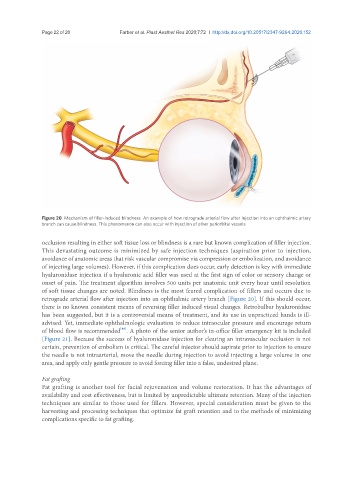Page 872 - Read Online
P. 872
Page 22 of 28 Farber et al. Plast Aesthet Res 2020;7:72 I http://dx.doi.org/10.20517/2347-9264.2020.152
Figure 20. Mechanism of filler-induced blindness. An example of how retrograde arterial flow after injection into an ophthalmic artery
branch can cause blindness. This phenomenon can also occur with injection of other periorbital vessels
occlusion resulting in either soft tissue loss or blindness is a rare but known complication of filler injection.
This devastating outcome is minimized by safe injection techniques (aspiration prior to injection,
avoidance of anatomic areas that risk vascular compromise via compression or embolization, and avoidance
of injecting large volumes). However, if this complication does occur, early detection is key with immediate
hyaluronidase injection if a hyaluronic acid filler was used at the first sign of color or sensory change or
onset of pain. The treatment algorithm involves 500 units per anatomic unit every hour until resolution
of soft tissue changes are noted. Blindness is the most feared complication of fillers and occurs due to
retrograde arterial flow after injection into an ophthalmic artery branch [Figure 20]. If this should occur,
there is no known consistent means of reversing filler induced visual changes. Retrobulbar hyaluronidase
has been suggested, but it is a controversial means of treatment, and its use in unpracticed hands is ill-
advised. Yet, immediate ophthalmologic evaluation to reduce intraocular pressure and encourage return
[48]
of blood flow is recommended . A photo of the senior author’s in-office filler emergency kit is included
[Figure 21]. Because the success of hyaluronidase injection for clearing an intravascular occlusion is not
certain, prevention of embolism is critical. The careful injector should aspirate prior to injection to ensure
the needle is not intraarterial, move the needle during injection to avoid injecting a large volume in one
area, and apply only gentle pressure to avoid forcing filler into a false, undesired plane.
Fat grafting
Fat grafting is another tool for facial rejuvenation and volume restoration. It has the advantages of
availability and cost effectiveness, but is limited by unpredictable ultimate retention. Many of the injection
techniques are similar to those used for fillers. However, special consideration must be given to the
harvesting and processing techniques that optimize fat graft retention and to the methods of minimizing
complications specific to fat grafting.

